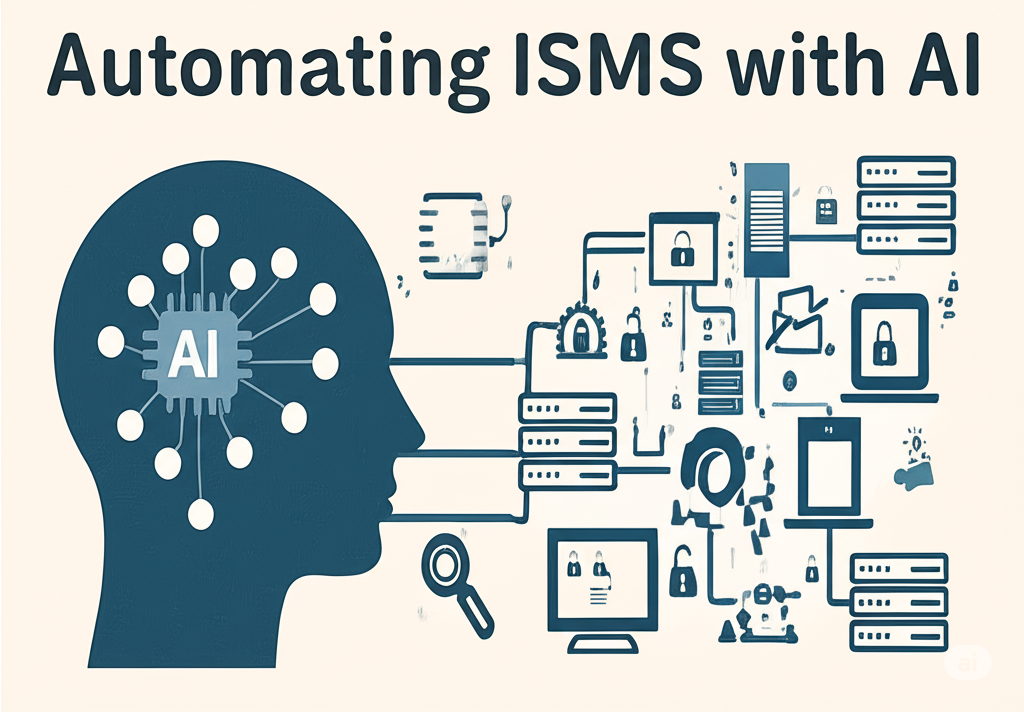Learn how automating ISMS with machine learning simplifies ISO 27001 compliance. Discover AI-driven strategies for efficient information security management
Achieving ISO 27001 compliance is a significant milestone for any organization. As the global standard for information security management systems (ISMS), ISO 27001 outlines the policies, processes, and technologies needed to protect sensitive data. But the reality for many compliance teams is that ISO 27001 is complex, time consuming, and resource intensive, until now.
Thanks to advancements in artificial intelligence, organizations can begin automating ISMS with machine learning, making ISO 27001 not only achievable but also sustainable. By integrating AI and automation into your ISMS, you can accelerate risk assessments, streamline documentation, and gain real time insights that transform compliance from a manual checklist to a dynamic security posture.
This guide breaks down how to simplify ISO 27001 using machine learning, why traditional approaches fall short, and how your business can benefit from ISO 27001 automation powered by intelligent technologies.
Why ISO 27001 Is More Important Than Ever
In today’s interconnected world, customers, regulators, and partners expect organizations to manage information securely. ISO 27001 is a clear signal that your company takes data protection seriously.
Yet maintaining compliance is challenging. Most ISMS frameworks involve:
- Manual risk assessments
- Static spreadsheets
- Disconnected policies and controls
- Time intensive audits
These outdated approaches struggle to keep up with today’s threats and scale. That’s where automating ISMS with machine learning comes in, giving organizations the tools to operationalize ISO 27001 continuously and intelligently.
The Power of Machine Learning in Information Security
Machine learning excels at identifying patterns, predicting outcomes, and automating repetitive tasks, all core elements of information security management. When applied to ISMS, machine learning enables organizations to:
- Detect risks in real time
- Predict vulnerabilities based on historical data
- Automate documentation and reporting
- Monitor compliance continuously
In short, AI in information security management turns reactive compliance into proactive protection.
Common Pain Points in ISO 27001 Implementation
Before diving into automation, it’s important to recognize the barriers many teams face in achieving and maintaining ISO 27001 certification:
- Inconsistent documentation: Policies and controls are often updated manually, leading to gaps and inconsistencies.
- Delayed risk assessments: Static assessments become outdated quickly and fail to reflect emerging threats.
- Audit fatigue: Preparing for audits drains resources, especially when evidence is spread across systems.
- Lack of visibility: Organizations struggle to track compliance status in real time.
These challenges are why automating ISMS with machine learning is no longer a luxury; it’s a necessity.
How Machine Learning Simplifies ISO 27001
1. Real Time Risk Assessment
Traditional risk assessments are conducted periodically, often annually or quarterly. But today’s threat landscape changes hourly. Machine learning models trained on historical security events, industry benchmarks, and internal activity can identify risks as they emerge.
For example, if a user starts accessing unusual files at odd hours or a new vulnerability appears in a third party system, AI can flag and rank the risk immediately.
This enables your ISMS to stay dynamic and responsive, a key tenet of ISO 27001 automation.
2. Intelligent Asset Classification
One of the most critical components of ISO 27001 is understanding which assets need protection. Instead of manually identifying and categorizing assets, machine learning can analyze usage patterns, access histories, and metadata to automatically classify data by sensitivity and value.
This ensures that your protective controls are aligned with actual business risk, a huge step forward in automating ISMS with machine learning.
3. Continuous Control Monitoring
Controls are only effective if they’re consistently applied. AI tools can continuously monitor whether access controls, encryption standards, and logging mechanisms are functioning as intended.
Rather than discovering a misconfigured firewall during an annual review, you’re alerted to the issue as soon as it occurs.
This is where AI in information security management provides measurable security improvements, not just compliance box ticking.
Automating Documentation and Audit Readiness
Audit preparation is one of the most time consuming parts of maintaining ISO 27001 compliance. Documenting controls, evidence, and policies typically takes weeks or even months.
Machine learning can automate much of this process:
- Track and log compliance activities in real time
- Auto generate audit trails and evidence
- Suggest control updates based on changes in business operations or regulations
With ISO 27001 automation, you move from scrambling for documentation to having an always ready audit environment.
The Benefits of Automating ISMS with Machine Learning
Implementing machine learning in your ISMS delivers tangible results:
1. Reduced Operational Burden
Automation replaces tedious tasks with real time intelligence, allowing your team to focus on strategic security initiatives rather than manual compliance activities.
2. Improved Accuracy
AI algorithms can detect inconsistencies, flag outdated policies, and catch misconfigurations that humans might miss, making your ISMS more robust.
3. Scalable Compliance
As your organization grows, your ISMS scales with you. Machine learning handles growing datasets, assets, and risk profiles without requiring exponentially more human resources.
4. Faster Time to Certification
By simplifying documentation and risk management, you can achieve ISO 27001 certification more quickly and with fewer roadblocks.
How to Start Automating Your ISMS with Machine Learning
Step 1: Assess Current Maturity
Begin by evaluating your current ISMS maturity. Identify which processes are manual, which systems are siloed, and where gaps exist in risk visibility.
Step 2: Choose the Right Tools
Look for platforms purpose built for automating ISMS with machine learning. The right solution should integrate seamlessly with your existing tools, support ISO 27001 control frameworks, and offer continuous monitoring and reporting.
Step 3: Map Controls to Automation
Work with your compliance and security teams to determine which ISO 27001 controls can be automated. Start with high impact areas such as access controls, incident response, and asset management.
Step 4: Train Models and Set Benchmarks
Ensure your AI models are trained on relevant data, historical incidents, industry threats, and internal behavior patterns. Establish baselines to detect anomalies accurately.
Step 5: Monitor, Improve, and Report
Once automation is live, regularly evaluate performance. Machine learning systems improve over time, but human oversight ensures they stay aligned with your business objectives and risk appetite.
Common Misconceptions About ISMS Automation
While automation offers clear benefits, some myths still persist:
- “Automation removes human control.”
In reality, machine learning supports decision making, it doesn’t replace it. Compliance teams retain oversight and validation authority. - “It’s too expensive.”
The upfront investment in automation often pays for itself by reducing audit costs, avoiding penalties, and freeing up internal resources. - “It’s only for large enterprises.”
Today’s AI solutions are scalable and modular, making them accessible to SMBs as well as enterprises.
Understanding how to simplify ISO 27001 starts with challenging outdated assumptions about what compliance looks like.
The Future of ISO 27001 Compliance
As regulatory landscapes evolve, static compliance practices won’t be enough. Whether it’s GDPR, HIPAA, or ISO 27001, regulators are moving toward continuous assurance and real time evidence.
Organizations that embrace ISO 27001 automation will not only meet compliance requirements but also strengthen resilience, accelerate digital transformation, and build trust with stakeholders.
By automating ISMS with machine learning, you future proof your compliance efforts against both known and emerging risks.
Conclusion
ISO 27001 doesn’t have to be complicated. By leveraging the power of AI and machine learning, compliance becomes faster, smarter, and more reliable.
Whether you’re pursuing certification for the first time or looking to modernize an existing ISMS, now is the time to integrate intelligent automation into your strategy. From risk assessments to audit prep, automating ISMS with machine learning empowers your organization to treat compliance as a continuous process, not a periodic challenge.
Frequently Asked Questions (FAQs)
Q) What does automating ISMS with machine learning mean?
It means using AI tools to manage ISO 27001 processes like risk assessment, asset classification, control monitoring, and audit preparation automatically.
Q) Why is ISO 27001 automation important?
It reduces human error, speeds up compliance, and makes it easier to maintain an effective information security management system as your organization scales.
Q) Can AI help with all parts of ISO 27001?
Not all, but many components, such as documentation, risk detection, and access control monitoring, can be efficiently handled by machine learning models.
Q) How do I choose a tool for ISO 27001 automation?
Look for platforms that support AI in information security management, offer pre built ISO 27001 frameworks, and integrate with your existing IT environment.
Q) Is automating ISMS only for tech companies?
No. Any organization handling sensitive information, finance, healthcare, education, and more, can benefit from simplifying ISO 27001 with AI.
Q) How secure is an AI driven ISMS?
Very secure, especially when combined with human oversight. AI can detect risks faster and apply controls more consistently than manual systems.
Q) How long does it take to implement automation?
Implementation time varies based on organizational complexity, but many companies begin to see value within the first few months.



